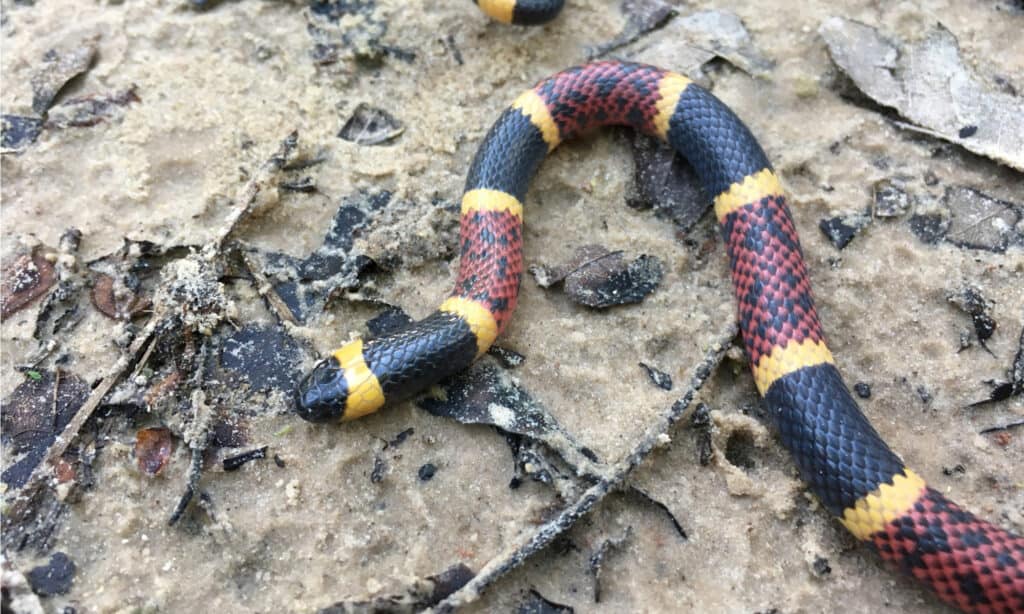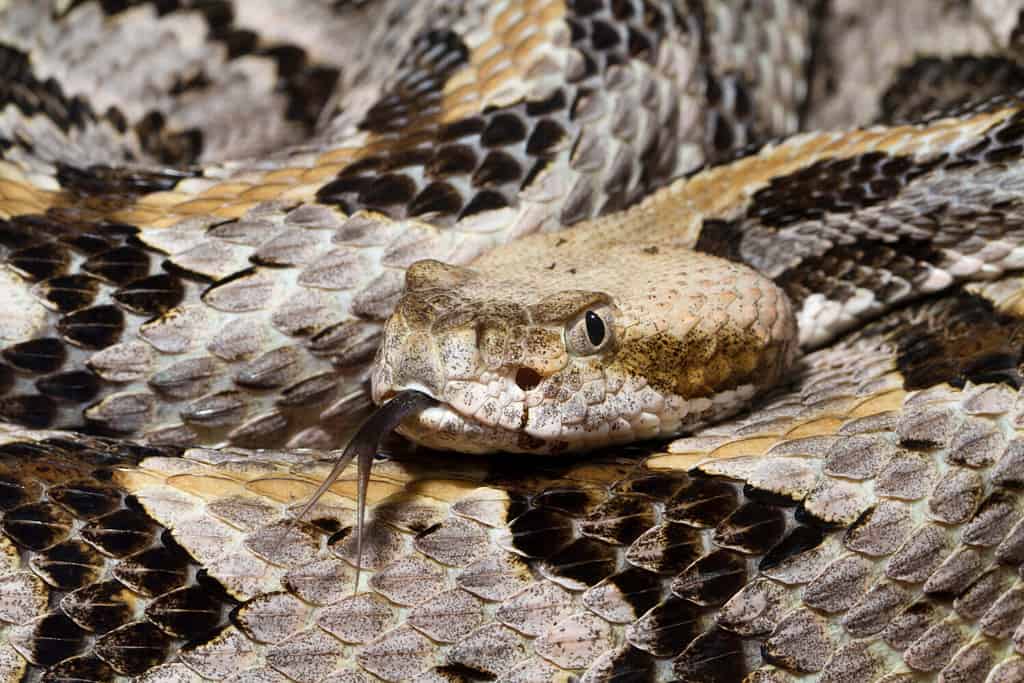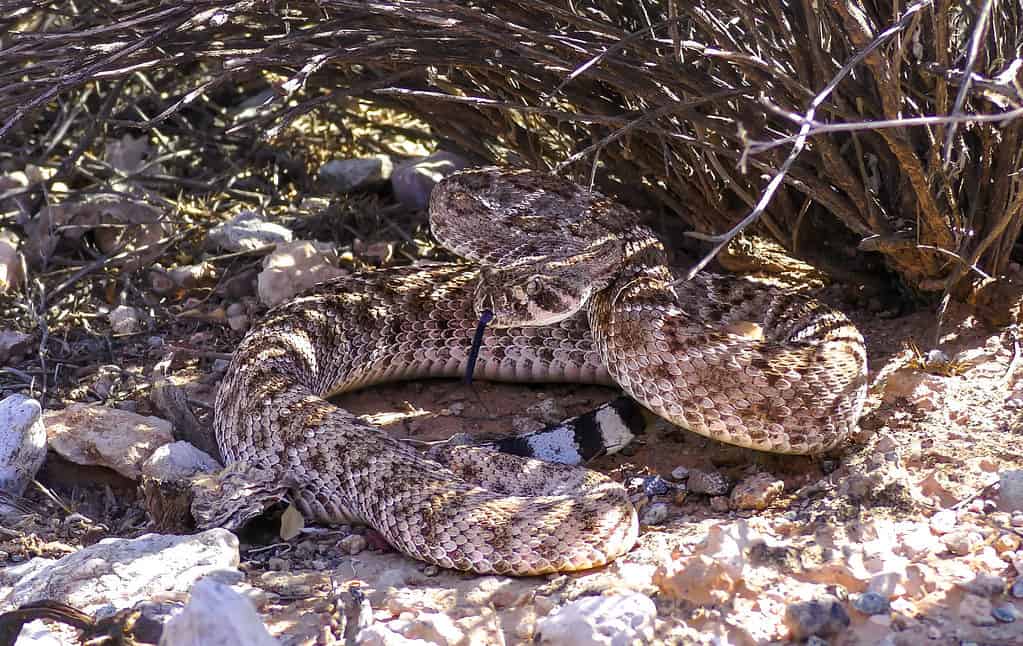Texas is the second-largest US state and is home to a vast range of animals, including numerous snakes. There are around 100 different species of snakes in the state and 15 of them are venomous. With so many snakes in the state, it’s inevitable that sometimes bites do occur. So, keep reading to discover the scariest snake bite incidents in Texas this year!
Dangerous Snakes in Texas
The venomous snakes in Texas include copperheads, cottonmouths, rattlesnakes, and coral snakes. So, before we dive into the list of snake bites that have occurred, we’ll quickly outline the most dangerous snakes in Texas.
Coral Snake

Texas coral snakes are one of around 15 venomous snakes in Texas.
©Joe Farah/Shutterstock.com
The Texas coral snake is a species of the coral snake and has a distinctive red, yellow, and black coloration. They can reach four feet long and have powerful neurotoxic venom.
Timber Rattlesnake
Timber rattlesnakes are one of the largest and most dangerous snakes in the US. They can reach five feet long and have heavy bodies which are dark brown with black crossband markings. They have particularly long fangs and a high venom yield.
Western Diamondback Rattlesnake
Western diamondback rattlesnakes typically reach four to five feet long and have grayish-brown bodies with darker diamond-shaped markings. They live in a wide variety of habitats and are one of the most common rattlesnakes in Texas.
Snake Bites in Texas
Texas currently ranks as the state that receives the highest number of venomous snake bites per year with a total of 1,408 as of July. This is significantly more than North Carolina (856) and Georgia (530). Although not all snake bites turn out to be dangerous, there are still some that make the headlines as being particularly scary. Let’s take a look at them below.
March 8, 2023
The first incident on the list is a reminder that even our K-9 heroes are at risk from venomous snakes. Lenin, a two-year-old K-9 with the Baytown Police Department, was bitten by a rattlesnake while completing a training exercise. Unfortunately, despite being rushed to a veterinarian for treatment, Lenin died as a result of the bite. Lenin’s role in the department involved detecting explosive devices and he won several awards in competitions against other K-9s.
April 2, 2023
The next incident occurred in Travis County when a man was bitten on the leg by a rattlesnake as he walked to his garden shed. He was airlifted to hospital and successfully treated with anti-venom. The species of the snake was not identified, but it was reported to be only one foot long.
April 9, 2023
On April 9, 11-year-old Dominic Gonzalez was bitten by an unidentified rattlesnake on the family ranch in Freer. The boy was bitten on his leg and was rushed to hospital where he required five bouts of anti-venom and a blood transfusion. He stayed in the hospital for more than a week but eventually recovered.
July 25, 2023

A snake more than four feet long dropped out of the sky onto a Texas woman.
©Mark_Kostich/Shutterstock.com
Easily the most terrifying incident to occur in Texas so far this year occurred on a July evening in Silsbee when Peggy Jones was mowing her lawn, completely unprepared for what happened next — a snake fell from the sky. The snake landed on Jones and immediately began striking at her, but that’s not all, as then a hawk swooped down and also attacked. The hawk was likely the same bird that had dropped the snake and wasn’t going to give up its meal without a fight. The bird pecked and clawed at Jones before it managed to capture the snake and flew away with it. Although Jones’ arm was injured by the hawk, she was not seriously injured by the snake. It’s not known what species the snake was, but Jones estimated it to be more than four feet long.
What Should You Do if You See a Venomous Snake in Texas?
Snakes often hide in crevices underneath logs and rocks, so never put your hand into any dark or covered area. However, you may sometimes come across a snake out in the open. If you do come across a venomous snake then the snake will naturally want to quickly get away from you. You should move back to a safe distance and allow the snake to move away. If the snake doesn’t move away then give it a wide berth and continue moving away from it. Do not ever attempt to pick the snake up or move it out of your way.
What Should You Do if You Are Bitten by a Venomous Snake?

If you are bitten by a venomous snake you should seek medical attention immediately.
©iStock.com/Banu R
Snakes are not aggressive animals and do not want to hurt you, but they are easily frightened. If a snake is cornered or feels threatened by you then it may react and attempt to strike at you as a means of defending itself.
If you are bitten by a venomous snake, then the first thing to do is to remain calm. You should seek medical attention immediately, as you have the best chance of a quick and full recovery if anti-venom is administered soon after the bite has occurred.
Do not attempt to cut out the venom or suck it out of the wound (it doesn’t work). Instead, keep the wound below your heart level while you’re waiting for help. Even if you think the bite isn’t that serious you still need to get it checked out as symptoms can quickly become worse the longer the wound is left untreated. If it’s possible to do so from a safe distance then it’s a good idea to get a photograph of the snake as this can help to identify the type of venom that it has injected and how to treat it.
The photo featured at the top of this post is © Joe McDonald/Shutterstock.com
Discover the "Monster" Snake 5X Bigger than an Anaconda
Every day A-Z Animals sends out some of the most incredible facts in the world from our free newsletter. Want to discover the 10 most beautiful snakes in the world, a "snake island" where you're never more than 3 feet from danger, or a "monster" snake 5X larger than an anaconda? Then sign up right now and you'll start receiving our daily newsletter absolutely free.
Thank you for reading! Have some feedback for us? Contact the AZ Animals editorial team.






